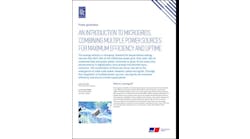If neighborhoods controlled their power supply, chances are many would opt for clean and efficient energy, especially if it’s cost-effective.
But energy choices aren’t left to the locals in the United States. Instead, utilities, cities and states determine our mix of power plants.
Communities might have more say if they develop their own microgrids. But there are some practical issues to resolve before we see community microgrids emerge in great numbers.
The Clean Coalition, a California-based non-profit, is looking for ways to make it easier. The organization hopes to create a kind of plug-and-play method for community microgrids that others can replicate throughout the United States
The testing ground is Hunters Point, a community in southeastern San Francisco that has struggled for decades with poverty, unemployment and toxic waste following the closing of a shipyard.
San Francisco has targeted the area for economic revitalization. As part of the project, the Clean Coalition is studying the feasibility of installing a large community microgrid. The grid-connected microgrid would generate most of its power, about 50 MW, from solar installations on rooftops or in parking lots. The microgrid would serve about 20,000 residential and commercial utility customers in the area.
What makes the Hunters Point Community Microgrid interesting – and challenging – is that it adds a lot of generation onto the utility distribution system, a part of the grid that wasn’t designed for the task. Power plants typically interconnect into the grid via long-distance transmission, not local distribution lines.
Working in partnership with the local utility, Pacific Gas & Electric, the Clean Coalition is modeling how to integrate bulk power onto the grid at the substation level.The group wants to make the process practical and cost effective, so that others can use the model. The project is significant not only to microgrids, but also to the growing number of community solar projects gaining traction nationwide.
“We want to show what needs to be done in order to take what is unknown today – how much can the distribution grid support in terms of intermittent renewables – and make that a known,” said Greg Thomson, the Clean Coalition’s director of programs.
The team is trying to determine how much renewable energy the substation can handle without upgrades or added energy storage.
It’s like studying how many cars a road can carry,” he said. “You have to know what kind of road you have – is it a two lane windy country road or four lane highway?”
The group has been collecting and validating baseline data about the local distribution system, and then modeling what happens to voltage and other grid functions as renewables are added. The team then re-configures the model with smart grid technologies, such as advanced inverters, storage and demand response, to see how they influence renewable capacity and system cost. The project also examines the additional complexity created by ‘islanding’ away from the main grid when it experiences a power outage.
The final product will pinpoint where and what amounts of solar can be added to the system. The organization wants to show that renewables can supply at least 25 percent of power consumed within a local distribution grid.
Ultimately, the team will offer a model that community microgrids elsewhere can replicate.
“The Hunters Point project is creating an approach that allows any utility, whether it is in California or elsewhere, to take existing tools and model the grid in this manner,” Thomson said. The goal is show that “a community microgrid with a high penetration of renewables, and a plug-and-play scale connection model, can happen anywhere.”
The Hunters Point Community Microgrid will not only add a significant amount of renewable energy to San Francisco, but also contribute $233 million to the regional economy, avoid $80 million in transmission-related costs over 20 years, reduce greenhouse gas emissions by 78 million pounds and save 15 million gallons of water annually.
More important, Hunters Point is sharing the secret sauce so that other communities can make similar gains.
Want to track the progress at Hunters Point? For updates, join our LinkedIn Group, Microgrid Knowledge or follow us on Twitter at @MicrogridNews.






